Ancient Quotations
Why Interpret Mesopotamian Inscriptions Differently?

Why do interpretations of Mesopotamian inscriptions vary? This query has baffled academics for generations. These ancient writings from an incredible civilization provide a fascinating peek into a bygone era. However, deciphering their mysteries is not straightforward. We encounter numerous hurdles that necessitate cautious and accurate analysis when dealing with these texts.
From variations in language and writing styles to the influence of cultural and religious beliefs, there are countless factors that contribute to the divergent interpretations. As we delve deeper into the historical context and immerse ourselves in the minds of ancient scribes, we begin to understand the complexity of deciphering these inscriptions.
Join us on this journey as we explore the fascinating world of Mesopotamian inscriptions and unravel the mysteries that lie within.
Key Takeaways
- Historical context and influences, such as the rise and fall of different empires in Mesopotamia, have shaped the writing styles and language used in inscriptions.
- Variations in language and writing styles exist in Mesopotamian inscriptions, influenced by regional dialects, the evolution of the written language, and external and internal political changes.
- Cultural and religious beliefs play a significant role in the interpretation of Mesopotamian inscriptions, as they affect the language, symbolism, and references to religious practices and rituals.
- Deciphering Mesopotamian inscriptions is challenging due to language variations, limited available sources, incomplete inscriptions, and cultural and historical gaps, requiring precise and cautious approaches for accurate interpretation.
Historical Context of Mesopotamian Inscriptions
In our interpretation of Mesopotamian inscriptions, we approach the historical context by examining the societal and cultural norms that prevailed during the time period in question. By studying the regional influences and archaeological evidence, we can gain valuable insights into the lives of the people who created these inscriptions.
Mesopotamia was a region that saw the rise and fall of various empires, such as the Sumerians, Akkadians, Babylonians, and Assyrians. Each of these empires left behind their own unique marks on the culture and society of the region. Through the analysis of inscriptions found in different areas of Mesopotamia, we can identify the specific influences that shaped the writing styles and language used.
Furthermore, the archaeological evidence provides us with a glimpse into the daily lives of the people who lived during this time. From the artifacts and structures unearthed, we can understand their religious practices, economic systems, and social hierarchies. This contextual understanding is crucial in interpreting the inscriptions accurately.
As we delve deeper into the historical context, we’ll explore the variations in language and writing styles used in Mesopotamian inscriptions. These variations can provide further insights into the cultural and societal nuances of the time period in question.
Variations in Language and Writing Styles
When examining Mesopotamian inscriptions, it becomes apparent that variations in language and writing styles exist. These variations can be attributed to the historical context and influences that shaped the development of writing systems in different regions.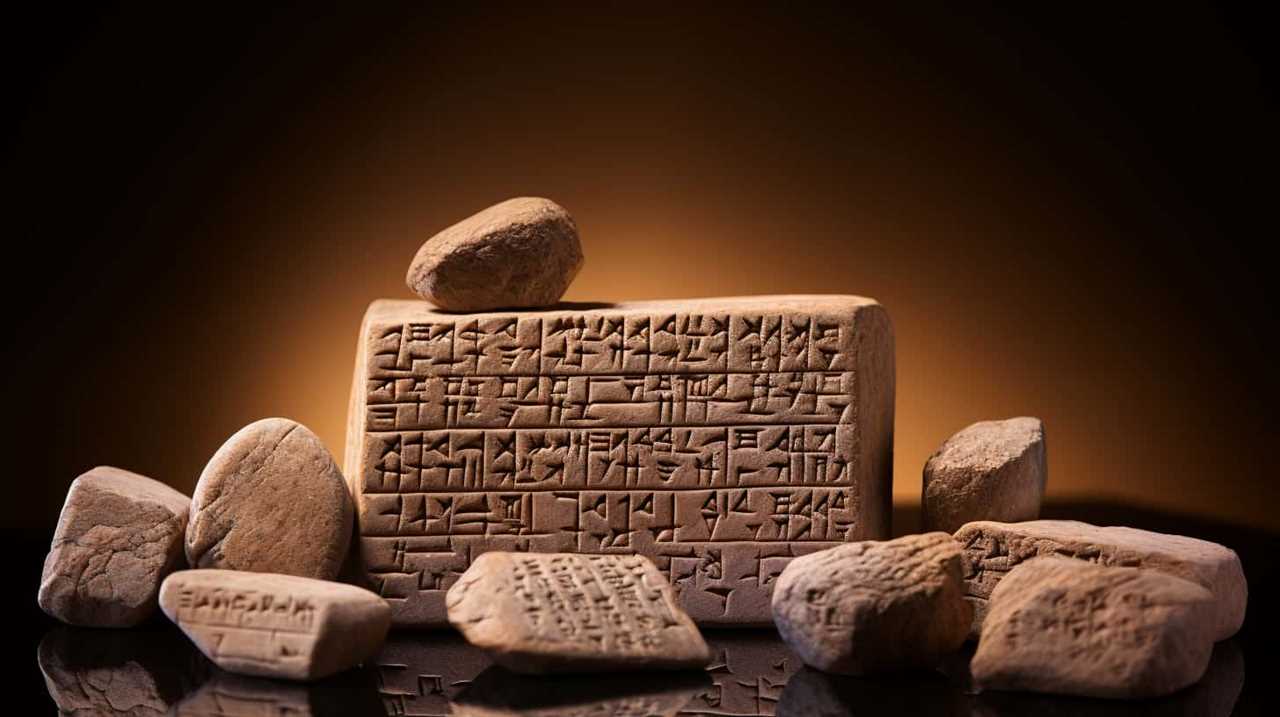
Additionally, regional dialects and the evolution of the written language over time further contribute to the diversity observed in Mesopotamian inscriptions.
Historical Context and Influences
Our interpretation of Mesopotamian inscriptions can vary due to the diverse historical contexts and influences that have shaped the language and writing styles within this ancient civilization. Understanding the historical context is crucial in deciphering and accurately interpreting these inscriptions.
Here are three key factors that contribute to the variations in language and writing styles:
- Regional Influences: Mesopotamia was home to various city-states, each with its own unique culture and language. The interactions and exchanges between these city-states led to the incorporation of different linguistic elements, resulting in variations in writing styles.
- Linguistic Evolution: Over time, the Mesopotamian language evolved, undergoing changes in vocabulary, grammar, and pronunciation. These linguistic changes impacted the way inscriptions were written, leading to variations in writing styles across different time periods.
- Cultural and Political Influences: Mesopotamia was influenced by neighboring civilizations such as Egypt and Persia. These external influences, along with internal political changes, had an impact on the language and writing styles used in inscriptions.
Regional Dialects and Evolution
Considering the historical context and influences, we can explore the impact of regional dialects and linguistic evolution on the variations in language and writing styles within Mesopotamian inscriptions.
The diversity of regional languages in ancient Mesopotamia played a crucial role in shaping the variations we see in the inscriptions. Different regions had distinct dialects and linguistic features, which contributed to the unique writing styles found in their inscriptions.
As time passed, these regional dialects evolved and underwent linguistic changes, further adding to the variations in language and writing styles. This linguistic evolution can be observed through the study of grammar, vocabulary, and syntax in the inscriptions.
Influence of Cultural and Religious Beliefs
The influence of cultural and religious beliefs shapes our interpretation of Mesopotamian inscriptions. When studying these ancient texts, it’s important to consider the cultural context in which they were created. Cultural influences play a significant role in shaping the meanings behind the inscriptions. Here are three key points to understand the impact of cultural and religious beliefs on our interpretation:
- Language and Symbolism: Cultural influences can affect the language and symbolism used in inscriptions. For example, certain words or phrases may have different connotations or associations based on cultural beliefs. Understanding the cultural context helps us interpret the intended meaning behind these linguistic choices.
- Rituals and Ceremonies: Religious beliefs often involve specific rituals and ceremonies. These practices may be referenced in inscriptions, providing insight into the religious traditions of the time. By understanding the religious beliefs and practices of ancient Mesopotamia, we can better interpret the inscriptions and their significance.
- Worldview and Values: Cultural and religious beliefs shape a society’s worldview and values. These beliefs influence how individuals perceive and interpret the world around them. When analyzing Mesopotamian inscriptions, it’s important to consider the underlying worldview and values of the culture in order to fully grasp the intended meaning.
Different Perspectives of Ancient Scribes
When examining the different interpretations of Mesopotamian inscriptions, it becomes evident that the perspectives of ancient scribes played a significant role. These scribes were influenced by various historical and cultural factors, which shaped their understanding and portrayal of events.
Additionally, the challenges of translating ancient languages further contribute to the divergent interpretations we encounter today. Therefore, it’s crucial to consider the unique perspectives of these scribes and the linguistic complexities involved in order to gain a more comprehensive understanding of Mesopotamian inscriptions.
Varying Historical and Cultural Influences
As ancient scribes, we interpret Mesopotamian inscriptions differently due to the varying historical and cultural influences that shape our perspectives. These influences can be categorized into three main factors:
- Regional influences: Mesopotamia was a region inhabited by multiple city-states, each with its own unique cultural practices and beliefs. This diversity resulted in variations in language, writing styles, and religious traditions. As scribes from different regions, we were exposed to distinct cultural contexts, leading to different interpretations of the inscriptions.
- Technological advancements: Over time, Mesopotamian society witnessed advancements in writing materials and tools. These advancements allowed for greater precision and clarity in inscriptions. However, the adoption of new technologies varied across different regions, leading to differences in the way inscriptions were recorded and interpreted.
- Historical events: Mesopotamia experienced numerous political, social, and economic changes throughout its history. These events influenced the perspectives of ancient scribes and shaped their interpretations of inscriptions. For example, a conquest or the rise of a new ruler could lead to reinterpretations of existing inscriptions to align with the new political order.
Linguistic Challenges in Translation
Interpreting Mesopotamian inscriptions differently is influenced by the linguistic challenges encountered by ancient scribes. Variations in translations can arise due to the inherent complexity of the Mesopotamian language and writing system. The cuneiform script, consisting of wedge-shaped characters, posed difficulties in accurately representing the phonetic sounds of the spoken language. This resulted in ambiguities and uncertainties when translating the inscriptions.
Additionally, the cultural influences on the scribes played a significant role in shaping their interpretations. Different regions within Mesopotamia had distinct dialects and linguistic variations, leading to variations in how the inscriptions were understood and translated. Furthermore, the socio-cultural context in which the scribes operated influenced their decision-making process, leading to different interpretations of the inscriptions.
Therefore, it’s crucial to consider the linguistic challenges faced by ancient scribes and the cultural influences on their translations when interpreting Mesopotamian inscriptions.
Evolution of Interpretation Methods
Over the years, we’ve seen a significant shift in the way we interpret Mesopotamian inscriptions. The evolution of interpretation techniques, coupled with the impact of technological advancements, has revolutionized our understanding of these ancient texts. Here are three key factors that have contributed to this evolution:
- Technological advancements in imaging and scanning techniques have allowed us to capture higher quality images of inscriptions. This has enabled scholars to decipher previously illegible or damaged texts, revealing new information and insights. For example, advanced imaging techniques have helped us identify faint traces of ink that were previously invisible to the naked eye.
- The development of computational linguistics has also played a crucial role in the interpretation of Mesopotamian inscriptions. By applying algorithms and statistical models to analyze the linguistic patterns within these texts, we can now better understand the grammar, vocabulary, and syntax of ancient languages. This has greatly improved our ability to translate and interpret inscriptions accurately.
- The interdisciplinary approach to interpretation has become increasingly prevalent. Scholars from various fields, such as archaeology, history, linguistics, and anthropology, collaborate to bring different perspectives and expertise to the interpretation process. This multidisciplinary approach allows for a more comprehensive understanding of the inscriptions and the societies that produced them.
As we dive into the impact of archaeological discoveries, it’s important to acknowledge how these evolving interpretation methods have laid the foundation for our current understanding of Mesopotamian inscriptions.
Impact of Archaeological Discoveries
As we explore the impact of archaeological discoveries on the interpretation of Mesopotamian inscriptions, it becomes evident that new evidence challenges previous understandings.
Recent excavations have provided valuable insights that shed light on aspects of Mesopotamian culture and society previously unknown.
These discoveries have prompted scholars to reevaluate their interpretations and revise existing theories, highlighting the dynamic nature of our understanding of ancient civilizations.
New Evidence Challenges Interpretations
Examining new evidence has challenged our interpretations of Mesopotamian inscriptions. As archaeologists, we constantly strive to uncover new findings that shed light on ancient civilizations. However, the discovery of new evidence often introduces contradictions and conflicting interpretations, forcing us to reevaluate our previous understanding.
Contradictions within the inscriptions: The new evidence reveals inconsistencies and contradictions within the Mesopotamian inscriptions. These discrepancies challenge our previous assumptions and require us to reconsider our interpretations.
Conflicting interpretations among scholars: The emergence of new evidence has also sparked debates among scholars, with different experts offering competing interpretations. This diversity of viewpoints underscores the complexity of deciphering ancient inscriptions and reinforces the need for ongoing research and analysis.
Reevaluation of established theories: The introduction of new evidence has compelled us to reevaluate established theories about Mesopotamian society, culture, and history. It forces us to question long-held beliefs and provides an opportunity to develop more nuanced and accurate interpretations.
As we delve deeper into the complexities of Mesopotamian inscriptions, the insights gained from recent excavations become invaluable in refining our understanding of this ancient civilization.
Insights From Recent Excavations
Through our recent excavations, we’ve gained valuable insights into the impact of archaeological discoveries on our understanding of Mesopotamian inscriptions. Recent linguistic discoveries have played a significant role in shaping our cultural understanding of this ancient civilization. These discoveries have allowed us to decipher and interpret previously unknown inscriptions, shedding light on the daily lives, beliefs, and traditions of the Mesopotamian people.

For example, the discovery of a new inscription at the site of Nippur has provided evidence of a previously unknown religious festival dedicated to the goddess Inanna. This inscription not only reveals the significance of Inanna in Mesopotamian religious practices but also offers insights into the social and political structures of the time.
Moreover, the discovery of well-preserved administrative records has allowed us to reconstruct the ancient Mesopotamian economy, providing a deeper understanding of their trade networks and economic systems.
Role of Modern Scholarly Debates
Our understanding of Mesopotamian inscriptions is shaped by the ongoing debates among modern scholars. These debates play a crucial role in refining our interpretations and shedding light on the complexities of this ancient civilization.
Two factors that have significantly impacted these debates are the role of technology and the lingering effects of colonialism.
- Role of technology: The advancement of technology, such as digital imaging and data analysis, has revolutionized the study of Mesopotamian inscriptions. High-resolution photographs and 3D imaging techniques allow scholars to examine inscriptions in greater detail, revealing previously unnoticed details. Additionally, computer software enables the translation and interpretation of complex cuneiform texts, aiding in the decipherment process. These technological advancements have expanded our understanding of Mesopotamian inscriptions and opened up new avenues of research.
- Impact of colonialism: The legacy of colonialism has had a profound influence on the interpretation of Mesopotamian inscriptions. Colonial powers often appropriated ancient artifacts and inscriptions, shaping the narrative and interpretation according to their own agendas. This Eurocentric bias has led to a distorted understanding of Mesopotamian culture and history. Modern scholars are now actively challenging these colonial interpretations, seeking to uncover the authentic voices and perspectives of the ancient Mesopotamians. By critically examining the historical context and challenging preconceived notions, scholars aim to present a more accurate and nuanced understanding of Mesopotamian inscriptions.
Significance of Comparative Analysis
Continuing our exploration of Mesopotamian inscriptions, let’s delve into the significance of conducting comparative analysis.
Understanding the importance of cross comparisons and the role of an interdisciplinary approach is crucial in deciphering the complexities of these ancient writings.
Comparative analysis allows us to examine multiple inscriptions from different time periods, regions, or cultures, enabling us to identify patterns, similarities, and differences. By comparing inscriptions, we can discern common themes, linguistic patterns, and cultural influences. This process helps us to develop a more comprehensive understanding of the inscriptions and the civilizations that produced them.
Moreover, the interdisciplinary approach is essential in analyzing Mesopotamian inscriptions. It involves integrating knowledge and methodologies from various fields such as archaeology, history, linguistics, and anthropology. Each discipline contributes unique perspectives and tools that contribute to a holistic interpretation of the inscriptions.
The importance of cross comparisons and an interdisciplinary approach can’t be overstated. They provide us with a broader context for understanding Mesopotamian inscriptions, allowing us to uncover hidden meanings and shed light on the ancient world. By utilizing these approaches, we can gain insights into the cultural, social, and political aspects of ancient Mesopotamia that may have been lost or overlooked.
As we explore further into the use of linguistics in understanding inscriptions, it becomes evident that language plays a crucial role in deciphering the messages encoded within these ancient texts.
Use of Linguistics in Understanding Inscriptions
To better understand Mesopotamian inscriptions, we can employ linguistic analysis, which allows us to decode the messages encoded within these ancient texts. Linguistics provides us with a systematic approach to studying language and its structures, enabling us to uncover the meaning behind the inscriptions.
Here are three ways in which linguistic analysis techniques aid our understanding of Mesopotamian inscriptions:
- Cross Cultural Comparisons: By comparing the language and writing systems used in Mesopotamian inscriptions with other ancient languages and cultures, we can identify similarities and differences. This comparative approach helps us uncover shared linguistic features and cultural influences, shedding light on the historical and social contexts in which these inscriptions were created.
- Phonological Analysis: Linguistic analysis allows us to study the sounds and pronunciation patterns used in Mesopotamian inscriptions. By examining the phonetics and phonology of the language, we can reconstruct the pronunciation of words and gain insight into the spoken language of the time. This knowledge enhances our understanding of the inscriptions and the culture that produced them.
- Morphological and Syntactic Analysis: Linguistics provides us with tools to analyze the structure of words and sentences in Mesopotamian inscriptions. By examining the morphological and syntactic features, we can identify the grammatical rules and patterns used in the language. This analysis helps us decipher the meaning of individual words and understand the overall message conveyed in the inscriptions.
Importance of Contextualizing Inscriptions
As we delve further into the topic of contextualizing inscriptions, it’s essential to consistently employ linguistic analysis techniques in order to accurately interpret Mesopotamian inscriptions. By examining the regional influences and employing linguistic analysis, we can gain a deeper understanding of the inscriptions and the civilizations that produced them.
Regional influences played a significant role in shaping the content and style of Mesopotamian inscriptions. Different regions had their own distinct cultural traditions and linguistic variations, which influenced the inscriptions found in those areas. For example, inscriptions from the Sumerian city of Ur may differ in language and content from inscriptions found in the Akkadian city of Babylon.
Linguistic analysis is a crucial tool in deciphering inscriptions. By studying the grammar, vocabulary, and syntax of the written texts, we can uncover valuable information about the context in which the inscriptions were created. This analysis allows us to make connections between different inscriptions and understand the cultural and historical significance of the messages conveyed.
Role of Political and Socioeconomic Factors
We will explore how political and socioeconomic factors shape the interpretation of Mesopotamian inscriptions. The role of language development plays a crucial part in understanding these ancient texts. As societies evolve, so does their language. Changes in language can influence the meaning and interpretation of inscriptions. For example, the introduction of new words or shifts in grammar can alter the understanding of specific phrases or symbols.
Additionally, the impact of trade routes can’t be underestimated. Trade routes facilitated the exchange of goods, ideas, and cultural practices among different civilizations in Mesopotamia. This cross-cultural interaction influenced the inscriptions found in these regions, as they often incorporated elements from other societies. Understanding the political and socioeconomic context in which these inscriptions were created is essential for accurate interpretation.
Political and socioeconomic factors provide the backdrop against which inscriptions were produced, reflecting the values, beliefs, and aspirations of the ruling elite. The power dynamics and economic conditions of the time shaped the content and tone of these inscriptions. For instance, inscriptions may glorify a ruler’s military conquests or highlight economic achievements such as the construction of grand buildings or irrigation systems. By considering the social and political context, we can gain valuable insights into the motivations and intentions behind the inscriptions.
Understanding the role of political and socioeconomic factors is crucial in deciphering Mesopotamian inscriptions. These factors influence the development of language and the content of the inscriptions themselves. By analyzing the political climate and economic conditions, we can better interpret the messages conveyed in these ancient texts.
Now, let’s delve into the challenges faced in translating and deciphering these inscriptions.

Challenges in Translating and Deciphering Inscriptions
Navigating the complexities of translating and deciphering Mesopotamian inscriptions poses significant challenges, requiring careful analysis of linguistic nuances and cultural contexts.
One of the major challenges in this process is the variations in translation methods employed by different scholars. Translating ancient texts isn’t an exact science, and different translators may approach the task with different methodologies, leading to variations in the interpretation of the inscriptions. Some translators may focus more on the literal meaning of the words, while others may prioritize the cultural and historical context surrounding the inscriptions.
Another challenge is the impact of technological advancements on the translation and decipherment of Mesopotamian inscriptions. In recent years, technological tools like computer software and digital imaging have revolutionized the field of ancient languages. These tools enable researchers to enhance and analyze inscriptions in ways that weren’t possible before. For example, advanced imaging techniques can help reveal faded or damaged parts of inscriptions, providing new insights into their meaning. Additionally, computer algorithms can assist in deciphering complex scripts by comparing them to known languages or decipherment patterns.
Implications for Understanding Ancient History
By examining the implications for understanding ancient history, we can gain a deeper insight into the significance of interpreting Mesopotamian inscriptions differently. The way we interpret these inscriptions has important implications for historical accuracy and our understanding of the past. Here are three key points to consider:
- Historical Accuracy: Interpreting Mesopotamian inscriptions differently can have a significant impact on our understanding of historical events. These inscriptions provide valuable insights into the political, social, and cultural dynamics of ancient Mesopotamia. However, if our interpretations are flawed or biased, it can distort our understanding of the past. Therefore, it’s crucial to critically analyze the inscriptions and consider multiple perspectives to ensure historical accuracy.
- Influence of Cultural Biases: Our cultural biases can greatly influence how we interpret and understand Mesopotamian inscriptions. Different scholars may approach the same inscription with different preconceived notions and interpretive frameworks based on their own cultural backgrounds. This can lead to conflicting interpretations and hinder our ability to uncover the true meaning of the inscriptions. It’s important to be aware of these biases and strive for objectivity in our interpretations.
- Reconstructing Ancient History: Interpreting Mesopotamian inscriptions differently can challenge existing narratives and force us to reevaluate our understanding of ancient history. It can reveal new perspectives, shed light on previously overlooked aspects, and provide alternative explanations for historical events. By embracing diverse interpretations, we can create a more nuanced and comprehensive understanding of the past.
Frequently Asked Questions
How Do Modern Scholars Determine the Accuracy of Their Interpretations of Mesopotamian Inscriptions?
Accuracy determination in interpreting Mesopotamian inscriptions involves employing a range of methods. These include linguistic analysis, comparison with other texts, consideration of cultural context, and consultation with experts.
What Role Did Political and Socioeconomic Factors Play in the Creation and Interpretation of Mesopotamian Inscriptions?
Political and socioeconomic factors greatly influenced the creation and interpretation of Mesopotamian inscriptions. The role of language and the influence of rulers shaped the inscriptions, leading to different interpretations by modern scholars.
How Has the Evolution of Interpretation Methods Affected Our Understanding of Mesopotamian Inscriptions?
Evolutionary impact of interpretation methods and linguistic analysis have significantly enhanced our understanding of Mesopotamian inscriptions. By examining inscriptions from various perspectives, we uncover new insights into the political, socioeconomic, and cultural aspects of ancient Mesopotamia.
What Challenges Do Scholars Face When Translating and Deciphering Mesopotamian Inscriptions?
When translating and deciphering Mesopotamian inscriptions, scholars face numerous challenges. These include the complexities of the language, the lack of contextual information, and the varying translation methods used throughout history.
How Have Archaeological Discoveries Impacted Our Understanding of Mesopotamian Inscriptions and Ancient History?
Archaeological evidence and historical context have greatly impacted our understanding of Mesopotamian inscriptions and ancient history. They provide valuable insights into the cultural, political, and social aspects of the time, allowing us to interpret the inscriptions differently.
What is the significance of interpreting Mesopotamian inscriptions differently compared to the profound language used by pharaohs and scribes?
The significance of interpreting Mesopotamian inscriptions differently compared to the profound language used by pharaohs and scribes’ language sophistication lies in uncovering unique cultural nuances and historical insights. Each civilization’s language sophistication offers distinct perspectives on societal values, beliefs, and technological advancements, enriching our understanding of ancient civilizations.
Conclusion
In conclusion, the differing interpretations of Mesopotamian inscriptions can be attributed to a multitude of factors. These include variations in language and writing styles, the influence of cultural and religious beliefs, the different perspectives of ancient scribes, and the evolution of interpretation methods.
Contextualizing inscriptions, considering political and socioeconomic factors, and the challenges of translation and decipherment are also crucial in understanding these ancient texts.
As we delve deeper into the complexities of Mesopotamian civilization, we’re left with the intriguing question: How can we truly grasp the depths of their history and culture through these inscriptions?

Fritz is a writer whose humor and wit infuse life into words. His creativity, combined with a profound love for the English language, makes him a unique voice at afterQuotes. Fritz’s engagement with books, culture, and social media adds depth to his contributions, making them resonate with our diverse audience.
Ancient Quotations
9 Best Mesopotamian Cuneiform Inscription Quotes Revealed

We have uncovered the top 9 quotes from Mesopotamian cuneiform inscriptions for those seeking timeless nuggets of wisdom.
While some may argue that these ancient texts are irrelevant in today’s modern world, we believe that the insights they offer are timeless and invaluable.
Through our diligent decoding of these enigmatic messages from the past, we have discovered a wealth of knowledge and wisdom that has been preserved in stone for centuries.
These powerful words, crafted by the skilled scribes of Mesopotamia, provide a glimpse into the rich literary treasures of this ancient civilization.
Join us as we delve into the secrets of Mesopotamian inscriptions and uncover the profound insights they hold.
Key Takeaways
- The oldest known writing system, cuneiform script, was developed by the Sumerians around 3200 BCE in Mesopotamia.
- Deciphering Mesopotamian inscriptions requires expertise in linguistics, archaeology, and history.
- Mesopotamian inscriptions reveal the cryptic secrets of Mesopotamian culture and history.
- Decoding symbols in Mesopotamian cuneiform is a complex task that requires linguistic analysis and comparison to known texts.
The Oldest Known Writing System
The discovery of the oldest known writing system in Mesopotamia has revolutionized our understanding of ancient civilizations. This breakthrough has shed light on the earliest forms of written communication and has provided valuable insights into the lives and cultures of ancient peoples.
The oldest writing techniques in Mesopotamia date back to around 3200 BCE, with the emergence of cuneiform script. Cuneiform was developed by the Sumerians and was used to record various aspects of their society, including administrative, economic, and religious matters. It consisted of wedge-shaped marks made on clay tablets using a stylus.
Deciphering ancient scripts has been a challenging task for scholars. However, the discovery of the oldest known writing system has provided a crucial starting point for unlocking the mysteries of ancient languages. By studying these ancient texts, linguists have been able to decipher the meanings of the symbols and gain valuable insights into the beliefs, customs, and activities of ancient civilizations.
The oldest known writing system hasn’t only expanded our knowledge of ancient cultures but has also highlighted the sophistication and complexity of these early civilizations. It’s a testament to the ingenuity and creativity of our ancestors, as they developed a method to record and preserve their thoughts and experiences for future generations.
The Secrets of Mesopotamian Inscriptions
When exploring the secrets of Mesopotamian inscriptions, we’re confronted with the oldest written language known to humanity. These inscriptions hold immense historical significance, providing valuable insights into the ancient civilizations that once thrived in Mesopotamia.
Deciphering the ancient script is a complex task, requiring expertise in linguistics, archaeology, and history, but it’s through this process that we can unlock the stories and knowledge preserved in these inscriptions.
Oldest Written Language
We delved into the secrets of Mesopotamian inscriptions, uncovering the fascinating origins of the oldest written language.
Mesopotamia, known as the cradle of civilization, was the birthplace of cuneiform script, which emerged around 3200 BCE. This ancient system of writing played a crucial role in the linguistic evolution of human communication.
The Sumerians, an ancient Mesopotamian civilization, were the first to develop this complex writing system, using wedge-shaped marks on clay tablets. Over time, cuneiform script spread throughout Mesopotamia, adapting to different languages such as Akkadian, Babylonian, and Assyrian.
This linguistic evolution allowed for the transmission of knowledge, literature, and legal records across generations. The decipherment of Mesopotamian inscriptions has provided valuable insights into the earliest forms of written communication, enriching our understanding of human history and culture.
Historical Significance and Context
Throughout our research, we frequently encountered the historical significance and context behind Mesopotamian inscriptions, providing us with valuable insights into their secrets. The historical preservation of these inscriptions has allowed us to unravel the rich tapestry of ancient Mesopotamian culture.
Here are four key points that highlight their cultural impact:
- Mesopotamian inscriptions serve as a written record of the civilization’s achievements, including their advancements in agriculture, architecture, and governance.
- These inscriptions provide evidence of the Mesopotamians’ complex religious beliefs and rituals, shedding light on their spiritual practices and worldview.
- The inscriptions also reveal the Mesopotamians’ fascination with astronomy and mathematics, showcasing their intellectual prowess.
- Additionally, these inscriptions offer glimpses into the daily lives and social structures of the Mesopotamian people, giving us a deeper understanding of their customs and traditions.
By delving into the historical significance and context of Mesopotamian inscriptions, we gain a profound appreciation for the impact of this ancient civilization.
Transitioning to the subsequent section, let’s now explore the intriguing process of deciphering ancient script.
Deciphering Ancient Script
During our research, we encountered the challenges and triumphs of deciphering the ancient script of Mesopotamian inscriptions, unveiling the secrets they hold.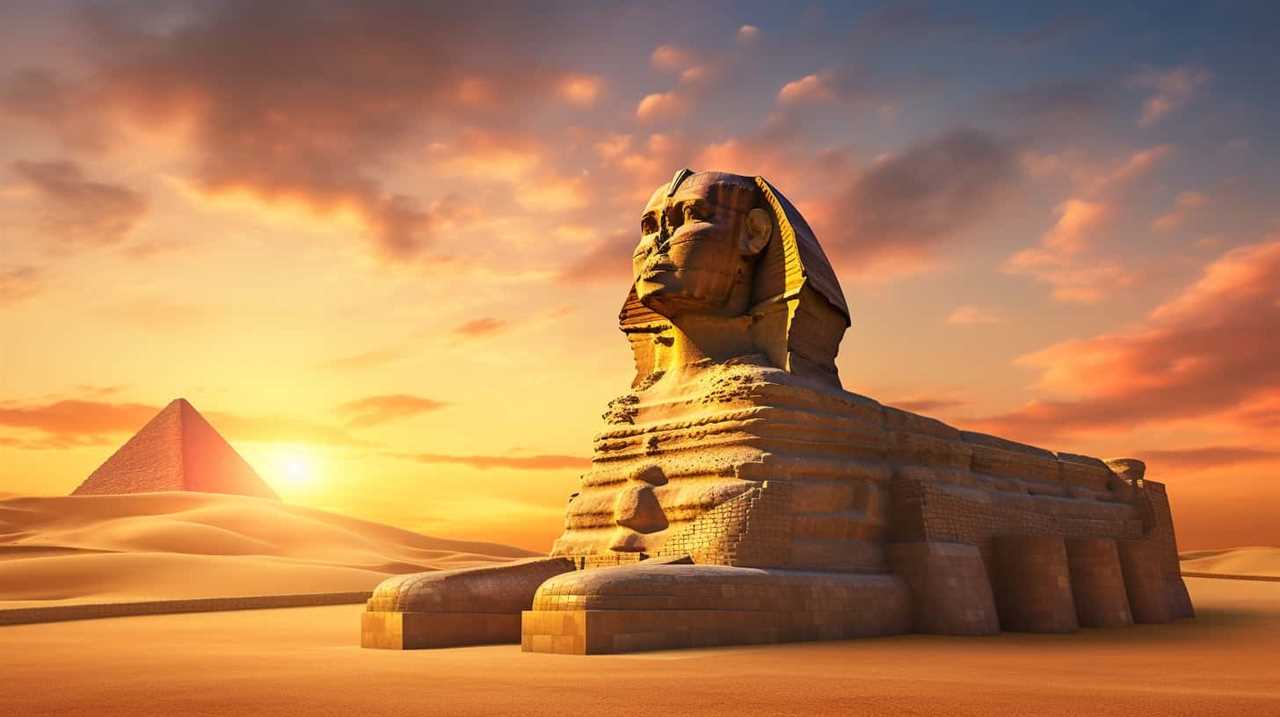
Decoding symbols in Mesopotamian cuneiform is a complex task that requires meticulous linguistic analysis. The script consists of a combination of wedges and lines, representing syllables, words, and phrases. Each symbol has multiple meanings, making it essential to consider the context in which it’s used.
Linguistic analysis plays a crucial role in deciphering these inscriptions, as it helps identify patterns and grammatical structures. By studying the language and comparing it to known texts, scholars can gradually decipher the symbols and unlock the meaning behind them.
The process of decipherment is time-consuming and requires expertise in ancient languages, but it’s essential for understanding the rich history and culture of Mesopotamia.
Unearthing Mesopotamia’s Ancient Quotes
The exploration of Mesopotamia’s ancient ruins has revealed a treasure trove of profound and thought-provoking quotes carved into cuneiform inscriptions. Uncovering lost wisdom and deciphering ancient symbols has allowed us to gain insight into the beliefs and values of the people who lived in this ancient civilization. These ancient quotes provide us with a window into their worldview and offer valuable lessons that still resonate with us today.
- ‘In the shadows of darkness, find the light within.’
- ‘The greatest strength lies in unity, for a single reed alone can’t make music.’
- ‘Do not let the sands of time erase the memory of your existence.’
- ‘Wisdom is the foundation upon which all knowledge is built.’
These quotes evoke a sense of introspection and contemplation, urging us to reflect on the human experience and consider our place in the world. They remind us of the timeless nature of wisdom and the enduring power of ancient civilizations. By studying these cuneiform inscriptions, we can uncover the wisdom of the past and gain a deeper understanding of our own existence.
Decoding the Cuneiform Inscriptions
Decoding the cuneiform inscriptions is a fascinating endeavor that allows us to understand the ancient writing techniques of Mesopotamia and uncover the historical significance hidden within these texts.
By analyzing the intricate symbols and deciphering the complex language, we gain valuable insights into the beliefs, customs, and daily life of the people who lived thousands of years ago.
The process of decoding cuneiform inscriptions requires meticulous attention to detail and a deep understanding of the cultural context, making it a vital tool in unraveling the mysteries of the ancient world.

Ancient Writing Techniques
We actively engage in deciphering ancient Mesopotamian cuneiform inscriptions through the meticulous study of writing techniques. By examining the methods used by ancient scribes, we gain a deeper understanding of how they encoded their messages onto clay tablets.
Here are some key ancient writing techniques that aid in the decoding process:
- Stylistic Variations: Different scribes had their own unique styles, which can help identify the author of a particular inscription.
- Phonetic Complementation: Cuneiform writing utilized a combination of logograms (representing whole words) and phonetic signs (representing individual sounds) to convey meaning.
- Numerical Systems: The ancient Mesopotamians had complex numerical systems that were incorporated into their writing, requiring a thorough understanding of mathematical concepts.
- Preservation Methods: Ancient scribes used various techniques, such as baking and sealing tablets, to ensure the longevity of their inscriptions.
Historical Significance of Cuneiform
Our exploration of the historical significance of cuneiform brings to light the invaluable insights gained from deciphering these ancient inscriptions.
Cuneiform, the earliest known form of writing, has had a profound cultural impact on the civilizations of Mesopotamia.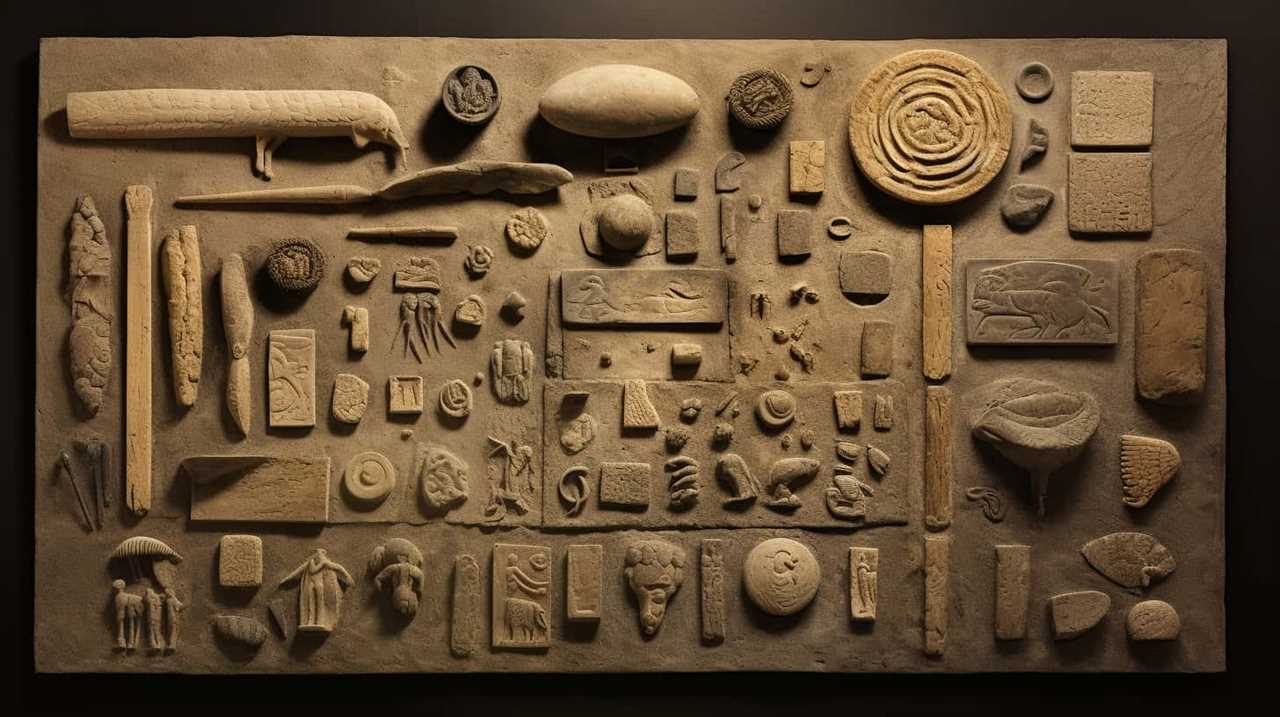
Through the decoding of cuneiform inscriptions, we’ve been able to uncover a wealth of knowledge about ancient Mesopotamian society, including their political systems, religious beliefs, and economic practices.
These inscriptions provide us with firsthand accounts of historical events, such as wars and conquests, as well as personal stories and legal documents.
The preservation techniques used in cuneiform, such as clay tablets and baked bricks, have allowed these ancient texts to survive for thousands of years, providing us with a window into the past and enriching our understanding of human history.
Insights From Ancient Cuneiform Texts
Through the analysis of ancient cuneiform texts, we gain valuable insights into the civilization and culture of Mesopotamia. These texts, written using ancient writing techniques, provide us with a window into the lives of the people who lived thousands of years ago. Deciphering ancient script has allowed us to uncover a wealth of information about their beliefs, social structures, and daily activities.

Here are some key insights we’ve gained from these texts:
- Religious practices: Cuneiform texts reveal the importance of religion in Mesopotamian society. They contain hymns, prayers, and rituals dedicated to various gods and goddesses, shedding light on their religious beliefs and practices.
- Legal systems: Cuneiform tablets also contain laws and legal codes that provide valuable information about the justice system in ancient Mesopotamia. They outline rules regarding property ownership, contracts, and penalties for crimes, giving us a glimpse into their legal framework.
- Economic activities: Cuneiform texts provide detailed records of economic activities such as trade, taxation, and agricultural practices. They offer insights into the organization of markets, the use of currency, and the management of resources in ancient Mesopotamia.
- Literary and artistic expressions: Cuneiform texts include epic poems, myths, and stories that showcase the literary and artistic talents of the Mesopotamian people. These texts allow us to appreciate their creativity and imagination, as well as the themes and motifs that were important to them.
Mesopotamian Wisdom Preserved in Stone
One can find a treasure trove of Mesopotamian wisdom preserved in stone through the study of cuneiform inscriptions. These ancient writings, etched onto tablets and monuments, provide valuable insights into the beliefs, values, and knowledge of the Mesopotamian civilization. The durability of stone has allowed these inscriptions to survive for thousands of years, offering us a glimpse into the past and shedding light on the intellectual and cultural achievements of this ancient society.
Mesopotamian wisdom, encompassing various aspects of life such as law, morality, and the nature of the divine, is beautifully encapsulated in these stone inscriptions. They reveal the Mesopotamians’ deep reverence for their gods and their belief in the interconnectedness of the natural and supernatural realms. These texts also provide practical advice on topics like farming, trade, and governance, showcasing the Mesopotamians’ practical knowledge and innovative thinking.
The preservation of Mesopotamian wisdom in stone is a testament to the importance placed on education and intellectual pursuits in this ancient civilization. The Mesopotamians recognized the value of recording their knowledge for future generations, ensuring that their wisdom would endure through the ages.
Transitioning into the subsequent section about ‘discovering Mesopotamia’s literary treasures,’ these stone inscriptions serve as a foundation for exploring the rich literary tradition of Mesopotamia. By studying these texts, we can unlock further insights into the intellectual, cultural, and literary achievements of this remarkable civilization.
Discovering Mesopotamia’s Literary Treasures
We are excited to explore Mesopotamia’s literary treasures, revealed through the study of cuneiform inscriptions. Mesopotamian literature holds immense historical and cultural significance, allowing us to gain profound insights into the lives and beliefs of ancient civilizations.
The importance of preserving these literary works can’t be overstated, as they provide a glimpse into the rich tapestry of Mesopotamian culture. They transport us back in time, enabling us to experience the thoughts, emotions, and experiences of people who lived thousands of years ago. They offer a unique perspective on the development of human civilization, shedding light on the intellectual and artistic achievements of the Mesopotamians.
They provide valuable information about the religious and mythological beliefs of these ancient societies, offering a window into their spiritual practices and worldview. They serve as a testament to the enduring power of storytelling, highlighting the universal human desire to communicate, entertain, and preserve knowledge.

The study of Mesopotamian literature not only enriches our understanding of the past but also helps us appreciate the timeless themes and ideas that continue to resonate with us today. By preserving and studying these literary treasures, we ensure that the voices of the ancient Mesopotamians aren’t forgotten, allowing their stories and wisdom to continue inspiring and enlightening future generations.
Enigmatic Messages From the Past
Continuing our exploration of Mesopotamia’s literary treasures, we delve into the enigmatic messages from the past revealed through the study of cuneiform inscriptions. These ancient writings, etched into clay tablets using a wedge-shaped stylus, offer a glimpse into the thoughts, beliefs, and daily life of the Mesopotamians. However, the symbols used in cuneiform script can be mysterious and challenging to decipher.
Deciphering techniques have been crucial in unraveling the secrets hidden within these inscriptions. Scholars have meticulously analyzed the patterns and variations in the symbols, comparing them with known texts and languages to identify commonalities and meanings. This process involves a deep understanding of the grammatical and linguistic structures of ancient Mesopotamian languages, such as Sumerian and Akkadian.
One such technique is the contextual approach, where researchers examine the surrounding text and the cultural context in which the inscription was created. By considering the purpose and audience of the writing, scholars can make educated guesses about the meaning of certain symbols or phrases.
Another technique involves comparing cuneiform inscriptions with other ancient texts, such as royal decrees, religious hymns, or legal documents. By identifying similarities in words and phrases, scholars can gradually build a lexicon of cuneiform symbols and their corresponding meanings.
Powerful Words of Mesopotamian Scribes
As we delve into the realm of Mesopotamian cuneiform inscriptions, we’re captivated by the power and eloquence exhibited in the words of these ancient scribes. The techniques employed by Mesopotamian scribes were truly remarkable, showcasing their mastery of the written word. Here are some examples of their literary wisdom that continue to resonate with us today:
- ‘The pen is mightier than the sword.’ This phrase, attributed to a Mesopotamian scribe, emphasizes the power of words to shape and influence society.
- ‘Knowledge is the key to unlocking the mysteries of the universe.’ Mesopotamian scribes recognized the importance of knowledge and the pursuit of wisdom in their writings.
- ‘Through writing, we immortalize our thoughts and experiences.’ Scribes understood the significance of preserving their ideas and experiences for future generations.
- ‘Words have the power to heal or harm.’ This statement highlights the responsibility of scribes in using their words wisely and ethically.
These insights into the world of Mesopotamian scribes provide a glimpse into the sophistication and intellectual depth of their society. Through their carefully crafted inscriptions, these ancient scribes left a lasting legacy of profound wisdom and literary excellence.
Frequently Asked Questions
How Were Cuneiform Inscriptions Used in Ancient Mesopotamia?
Cuneiform inscriptions were used for various purposes in ancient Mesopotamia. They served as a means of recording information, communicating ideas, and documenting legal, administrative, and religious matters. The significance of cuneiform writing cannot be overstated in understanding this ancient civilization.

What Tools Were Used to Create Cuneiform Inscriptions?
Tools and techniques used to create cuneiform inscriptions in ancient Mesopotamia included a stylus made of reed or bone, clay tablets, and a wedge-shaped writing system. These tools allowed for precise and durable writing.
How Were Cuneiform Inscriptions Deciphered and Translated?
Deciphering techniques for cuneiform inscriptions involved analyzing repeated signs, comparing them to known languages, and using bilingual texts. Translation methods included identifying word meanings, grammar rules, and context. It was a complex process requiring expertise and extensive knowledge.
Were Cuneiform Inscriptions Primarily Used for Practical or Decorative Purposes?
Cuneiform inscriptions were primarily used for practical purposes, such as record-keeping and communication. However, they also had cultural and historical significance, as they preserved important information about ancient Mesopotamian civilizations.
What Role Did Scribes Play in the Creation of Cuneiform Inscriptions?
Scribes played a crucial role in the creation of cuneiform inscriptions. Their expertise and knowledge were essential in preserving important information and recording historical events. The importance of cuneiform cannot be overstated as it provided a written record of Mesopotamian civilization.
Can you provide more Mesopotamian Cuneiform Inscription quotes similar to the ones you’ve already revealed?
Certainly! Here are some top Mesopotamian text quotes to further explore this ancient writing system: 1. “I am the queen, the gathering of the gods.” 2. “Oh, endless womb of the land, bearer of all things.” 3. “You are the storm, the roaring wind that brings life.
Conclusion
As we unravel the ancient cuneiform inscriptions of Mesopotamia, we’re transported to a world of wisdom and enigmatic messages. Through these powerful words, preserved in stone, we gain insights into the thoughts and beliefs of the past.
Each inscription is a literary treasure, holding secrets waiting to be decoded. Symbolizing the enduring power of knowledge, these inscriptions evoke a sense of awe and wonder, reminding us of the timeless connection between humanity and the written word.
Lauren’s talent in writing is matched by her passion for storytelling. Her love for books and deep understanding of culture and entertainment add a distinct flavor to her work. As our media and press contact, Lauren skillfully bridges the gap between afterQuotes and the broader media landscape, bringing our message to a wider audience.
Ancient Quotations
9 Powerful Stoicism Quotes to Conquer Challenges

Did you know that 90% of successful individuals adhere to the timeless principles of Stoicism? If you aim to conquer challenges and attain mastery in your life, then this is the perfect place for you to be.
In this article, we will explore 9 powerful Stoicism quotes that will equip you with the tools to overcome any obstacle that comes your way. Stoicism, with its focus on resilience, acceptance, wisdom, inner strength, discipline, embracing change, courage, finding peace, and cultivating virtuous qualities, provides a practical and actionable framework for personal growth and excellence.
By internalizing these Stoic principles, you can navigate life’s challenges with grace and emerge stronger, wiser, and more resilient than ever before. So, let’s dive into these empowering Stoicism quotes and unlock the secrets to conquering challenges.
Key Takeaways
- Stoicism encourages us to remain steadfast in the face of challenges and see obstacles as opportunities for growth.
- Stoicism emphasizes the importance of focusing on what we can control, such as our perception and response to challenges.
- Cultivating gratitude and practicing self-control are essential stoic virtues that foster resilience and inner calm.
- Stoicism teaches us to embrace change, recognize its inevitability, and adapt to it for personal growth and well-being.
Stoicism Quotes on Resilience
We frequently find solace and strength within stoicism’s teachings as they remind us of our own resilience in the face of adversity. Stoicism provides a practical philosophy that encourages us to remain steadfast and unwavering in the midst of life’s challenges. Stoic quotes on perseverance serve as powerful reminders of our ability to overcome obstacles and emerge stronger on the other side.
One such quote comes from Marcus Aurelius, who said, ‘The impediment to action advances action. What stands in the way becomes the way.’ This quote encapsulates the stoic belief that obstacles aren’t roadblocks, but rather opportunities for growth and progress. It reminds us that our response to adversity is within our control and that we’ve the power to transform obstacles into stepping stones towards success.
Another stoic quote on overcoming adversity comes from Epictetus, who stated, ‘It’s not what happens to you, but how you react to it that matters.’ This quote emphasizes the importance of maintaining a resilient mindset in the face of challenges. It reminds us that our perspective and attitude towards adversity can greatly influence our ability to overcome it.
As we delve into the topic of stoic quotes on acceptance, it’s important to recognize that resilience and acceptance often go hand in hand. Stoicism teaches us to accept the things we can’t change and to focus our energy on what we can control. Through this acceptance, we find the strength to persevere and overcome the adversities that life throws our way.
Stoic Quotes on Acceptance
As we explore stoic quotes on acceptance, it’s essential to understand the profound wisdom that Stoicism offers in embracing and embracing the things we can’t change. Stoicism teaches us the importance of surrendering to the realities of life and letting go of our attachments to outcomes.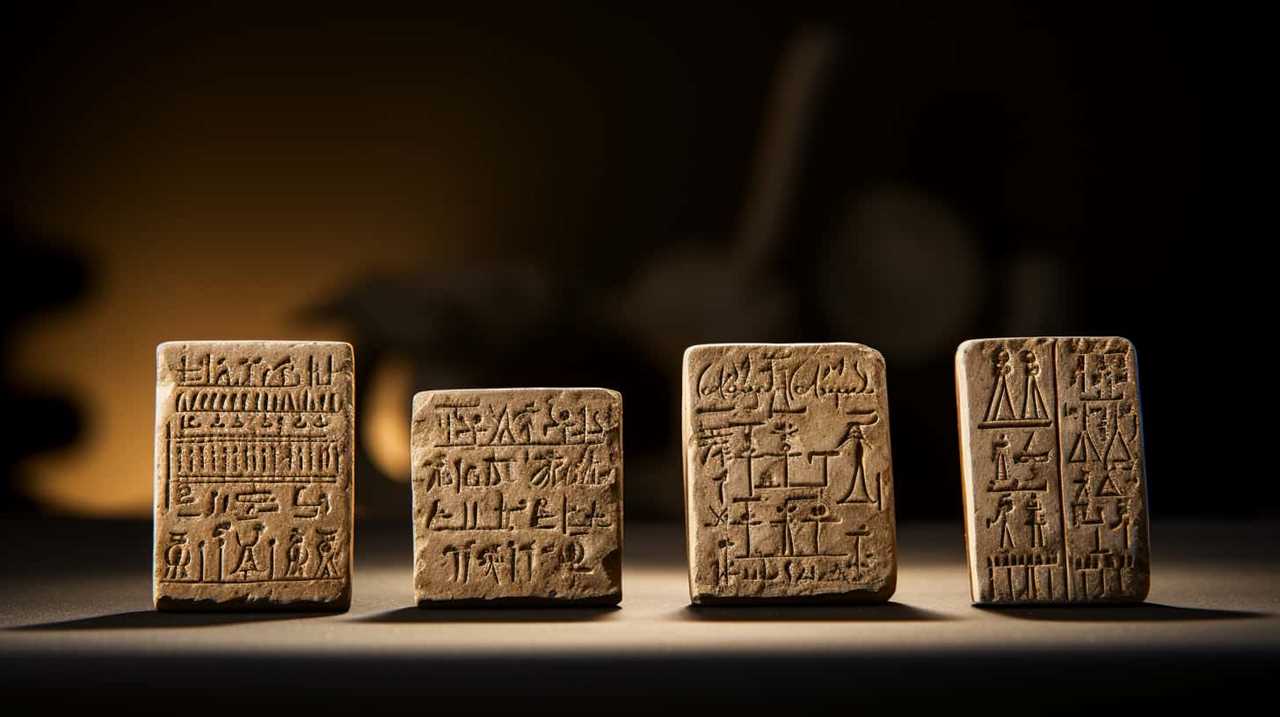
One powerful stoic quote on surrender comes from Epictetus, who said, ‘Do not seek to have events happen as you want them to, but instead want them to happen as they do happen, and your life will go well.’ This quote reminds us that we’ve no control over external events, and it’s futile to resist or try to change them. Instead, we should accept them as they’re and focus on our own inner state.
Another stoic quote on letting go comes from Marcus Aurelius, who said, ‘Accept the things to which fate binds you and love the people with whom fate brings you together, but do so with all your heart.’ This quote emphasizes the importance of accepting our circumstances and the people in our lives. It encourages us to embrace them fully, without resistance or judgment.
By accepting what we can’t change and letting go of our attachments, we free ourselves from unnecessary suffering and find peace within.
Quotes on Stoic Wisdom
When it comes to facing challenges, Stoic wisdom offers valuable insights that can help us develop resilience and navigate through difficult times.
Stoicism emphasizes the importance of internal strength and the ability to control our own thoughts and reactions.
Stoic Quotes for Resilience
Conquering challenges requires embodying stoic wisdom, which can be achieved by embracing resilience through powerful stoic quotes.
Stoicism quotes on inner strength serve as a guiding light, reminding us to stay strong and resilient in the face of adversity. One such quote by Marcus Aurelius states, ‘You have power over your mind – not outside events. Realize this, and you’ll find strength.’ This quote emphasizes the importance of focusing on what we can control, our own thoughts and actions, rather than being consumed by external circumstances.
Another stoic quote by Epictetus encourages us to develop resilience by accepting and adapting to the challenges we face: ‘It’s not what happens to you, but how you react to it that matters.’ This quote reminds us that our perception and response to challenges are within our control.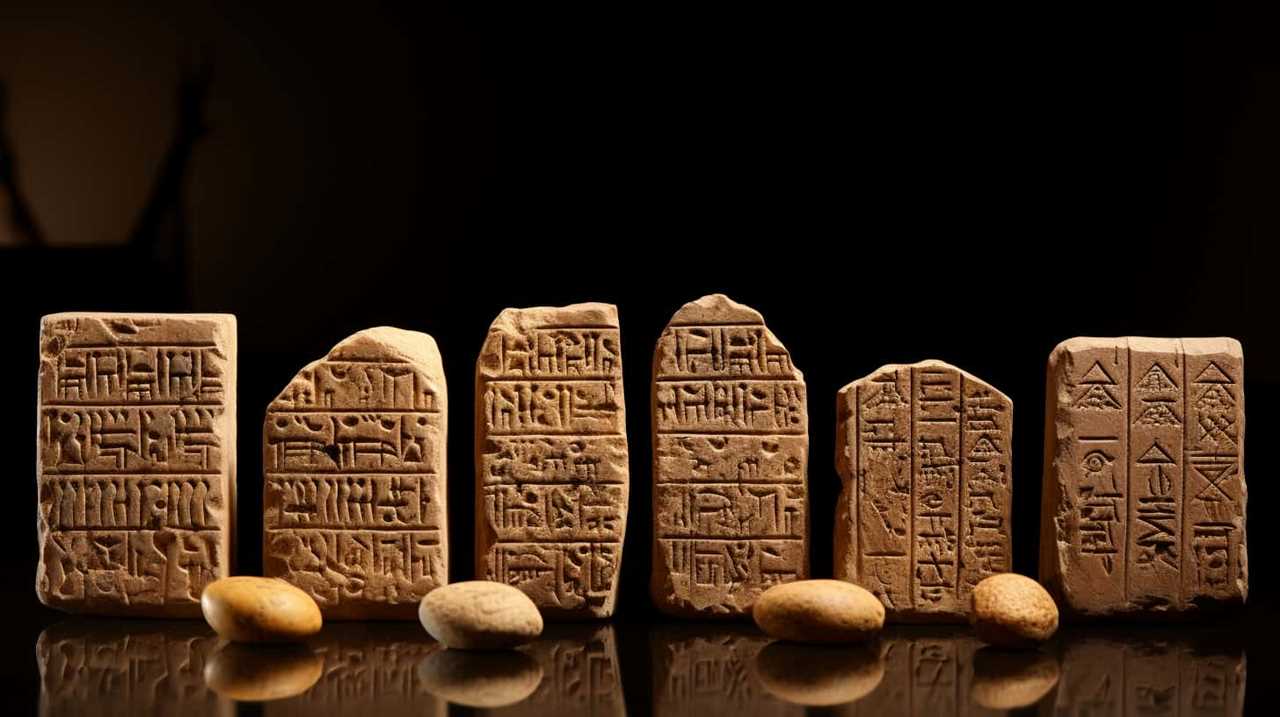
Applying Stoic Wisdom
To apply stoic wisdom in our lives, we can draw inspiration from powerful stoicism quotes that offer valuable insights and guidance. Stoic teachings, when applied in daily life, can help us navigate challenges with resilience and inner strength. By embracing stoic principles, we can cultivate a mindset that allows us to focus on what is within our control, rather than getting caught up in external circumstances. This shift in perspective empowers us to approach life’s difficulties with equanimity and acceptance. Stoicism teaches us to detach ourselves from outcomes and to instead focus on our own actions and attitudes. Through practicing gratitude, mindfulness, and self-reflection, we can develop a stoic mindset that enables us to face challenges head-on and find peace amidst chaos.
| Stoic Wisdom Quotes | Explanation |
|---|---|
| "The only thing you control is your own mind." | This quote reminds us that we have the power to control our thoughts and reactions, regardless of external circumstances. |
| "What upsets people is not things themselves, but their judgments about these things." | By recognizing that our judgments and interpretations shape our emotional responses, we can choose to adopt more rational and balanced perspectives. |
| "The obstacle is the way." | This quote emphasizes the stoic belief that obstacles and challenges are not to be avoided, but rather embraced as opportunities for growth and self-improvement. |
| "Amor fati." | This Latin phrase, meaning "love of fate," encourages us to embrace all aspects of our lives, both positive and negative, as essential parts of our journey. |
Stoicism Quotes on Inner Strength
As we explore Stoicism Quotes on Inner Strength, it becomes clear that the philosophy emphasizes the cultivation of resilience and resilience in the face of adversity. Stoic teachings provide valuable insights into developing our inner strength and overcoming challenges.
Here are three powerful stoicism quotes on self-control and overcoming adversity:
- ‘You have power over your mind – not outside events. Realize this, and you’ll find strength.’ – Marcus Aurelius
This quote reminds us that our strength lies within our ability to control our thoughts and reactions, rather than trying to control external circumstances. By focusing on our own attitudes and actions, we can cultivate inner resilience and face any adversity with grace.
- ‘The greater the difficulty, the more glory in surmounting it.’ – Epictetus
Epictetus teaches us that challenges are opportunities for growth and self-improvement. Instead of avoiding difficulties, we should embrace them as chances to showcase our inner strength and achieve greatness.
- ‘The obstacle is the way.’ – Ryan Holiday
This quote highlights the Stoic belief that obstacles aren’t setbacks but rather the path to success. By reframing obstacles as opportunities, we can tap into our inner strength and find creative solutions to overcome any adversity we encounter.
Stoic philosophy encourages us to develop our inner strength by practicing self-control and embracing challenges. By cultivating resilience and facing adversity head-on, we can conquer any obstacles that come our way and achieve true mastery in life.
Quotes on Stoic Discipline
With a focus on cultivating inner strength and resilience, stoic philosophy emphasizes the importance of discipline in navigating life’s challenges. Stoic discipline techniques provide a framework for developing self-control, mental fortitude, and emotional stability. These techniques, when applied in daily life, enable individuals to overcome obstacles and lead a virtuous and fulfilling existence.
To delve deeper into the concept of stoic discipline, let’s examine a table that highlights some key quotes from stoic philosophers on this topic:
| Stoic Discipline Quotes | Philosopher | Meaning |
|---|---|---|
| "The chief task in life" | Epictetus | The primary goal in life is to discipline our desires. |
| "Discipline your mind" | Marcus Aurelius | Train your mind to focus on what you can control. |
| "Self-control is strength" | Seneca | True strength lies in mastering oneself. |
| "Learn to be indifferent" | Epictetus | Embrace indifference towards external events. |
| "Endure and renounce" | Marcus Aurelius | Bear hardships and let go of attachments. |
These quotes underscore the importance of discipline in stoic philosophy. By practicing self-control, focusing on what is within our control, embracing indifference towards external outcomes, and letting go of attachments, we can navigate life’s challenges with resilience and inner strength.
Incorporating stoic discipline in daily life requires consistent effort and conscious decision-making. It involves recognizing our own desires, emotions, and reactions, and actively working towards aligning them with reason and virtue. By adopting stoic discipline techniques, we can cultivate a sense of inner harmony, withstand adversity, and live a life guided by wisdom and tranquility.
Stoic Quotes on Embracing Change
Embracing change can be challenging, but it’s important to recognize the hidden benefits that come with it.
Stoicism offers a valuable guide to adaptability, reminding us that change is inevitable and it’s how we respond to it that truly matters.
Embracing Change’s Hidden Benefits
Change brings about numerous hidden benefits that we, as individuals, often fail to recognize. Embracing change can be intimidating, as it requires us to step out of our comfort zones and face the unknown. However, when we overcome our fear of change, we unlock a world of possibilities and growth.
Here are three hidden benefits of embracing change:
- Personal growth: Change forces us to adapt and learn new skills, which leads to personal growth and development. It challenges us to step outside of our familiar routines and expand our horizons.
- Resilience: Embracing change teaches us resilience and the ability to bounce back from setbacks. It strengthens our mental and emotional muscles, preparing us to face future challenges with a positive mindset.
- Opportunities for success: Change often brings new opportunities that we may not have encountered otherwise. Embracing change opens doors to new experiences, relationships, and achievements that can lead to greater success in our personal and professional lives.
Stoicism’s Guide to Adaptability
When we embrace change, we gain valuable insights and practical wisdom from the teachings of Stoicism on adaptability, as exemplified by the following powerful stoic quotes.
The stoic mindset encourages us to recognize that change is inevitable and that our ability to adapt to it’s crucial for our growth and well-being. Stoicism teaches us that instead of resisting change or being overwhelmed by it, we should embrace it as an opportunity for growth and self-improvement.
By cultivating an adaptable mindset, we can navigate through life’s challenges with resilience and grace. Stoicism provides us with valuable tools and techniques for overcoming adversity and finding strength in the face of change. It reminds us that our true power lies in how we choose to respond to the ever-changing circumstances of life.
As we explore these stoic quotes on adaptability, we’ll gain a deeper understanding of how to embrace change and thrive in any situation.
Now, let’s transition into the next section where we’ll delve into stoic quotes on courage.
Quotes on Stoic Courage
As we delve into the realm of Stoic Courage, it becomes evident that embracing challenges with resilience and fortitude is essential for personal growth and triumph. Stoicism teaches us to face adversity head-on and to cultivate the inner strength needed to overcome any obstacle that comes our way.
Here are three powerful quotes on stoic courage that can inspire us to confront our challenges with unwavering determination:
- ‘The greater the difficulty, the more glory in surmounting it.’ – Epictetus This quote reminds us that the true measure of our courage lies in our ability to conquer difficult situations. By embracing challenges, we not only demonstrate our resilience but also create opportunities for personal growth and self-improvement.
- ‘Courage isn’t the absence of fear, but the triumph over it.’ – Seneca Seneca reminds us that courage isn’t the absence of fear, but rather the ability to face our fears and conquer them. It’s through confronting our fears that we develop the strength and courage necessary to overcome challenges.
- ‘Do not pray for an easy life; pray for the strength to endure a difficult one.’ – Bruce Lee This quote emphasizes the importance of developing inner strength and resilience. Instead of seeking an easy life, we should focus on building the fortitude to withstand difficult times. By doing so, we can face challenges head-on and emerge stronger on the other side.
As we explore stoic courage and its role in overcoming challenges, it becomes evident that finding peace within ourselves is an integral part of the journey.
Stoicism Quotes on Finding Peace
To attain inner tranquility, we must embrace stoicism’s wisdom on finding peace and incorporate its teachings into our lives. Stoicism offers invaluable insights into achieving tranquility and finding inner calm amidst the chaos of life. Let us explore some powerful stoicism quotes on finding peace:
| Quotes on Finding Peace |
|---|
| "The happiness of your life depends upon the quality of your thoughts." – Marcus Aurelius |
| "Peace is not the absence of conflict, but the ability to cope with it." – Epictetus |
| "The greatest obstacle to living is expectancy, which hangs upon tomorrow and loses today. You are arranging what lies in Fortune’s control, and abandoning what lies in yours." – Seneca |
| "If you are disturbed by external events, it is not the events themselves that trouble you, but only your own judgment about them. And it is in your power to wipe out that judgment now." – Marcus Aurelius |
These quotes remind us that finding peace requires a shift in mindset and the ability to control our thoughts and judgments. Stoicism teaches us that true tranquility comes from within, and that external events should not dictate our inner state. By practicing mindfulness and focusing on the present moment, we can cultivate a sense of calm and find peace even in the face of adversity. Stoicism’s wisdom on finding peace serves as a powerful guide for those seeking mastery over their own emotions and inner turmoil.
Quotes on Stoic Virtues
In our journey to conquer challenges, let’s delve into the wisdom of stoic virtues. Stoicism teaches us to cultivate certain qualities that can help us navigate life’s difficulties with resilience and inner strength. Here are some powerful stoic quotes on gratitude and self-control:
- ‘Gratitude isn’t only the greatest of virtues but the parent of all others.’ – Marcus Tullius Cicero
Gratitude is a foundational virtue that enables us to appreciate the present moment and find joy in the simple things. By cultivating gratitude, we can shift our focus from what we lack to what we already have, fostering contentment and resilience.
- ‘No man is free who isn’t master of himself.’ – Epictetus
Self-control is a crucial virtue that allows us to govern our desires, emotions, and actions. By practicing self-control, we can resist impulsive behavior, make rational decisions, and maintain inner calm in the face of challenges.
- ‘He is a wise man who doesn’t grieve for the things which he’s not, but rejoices for those which he has.’ – Epictetus
This quote reminds us of the importance of focusing on what we’ve rather than dwelling on what we lack. By cultivating a mindset of abundance and gratitude, we can find joy and contentment in our present circumstances, regardless of external circumstances.
Incorporating these stoic virtues of gratitude and self-control into our lives can help us navigate challenges with grace and mastery.
Frequently Asked Questions
What Are Some Practical Steps to Cultivate Resilience in Daily Life?
To cultivate resilience in daily life and overcome challenges, we must actively seek out opportunities for personal growth, maintain a positive mindset, and embrace adversity as a chance to learn and become stronger.
How Can Stoic Principles Help Individuals in Accepting Difficult Circumstances?
Stoic principles offer valuable insights for accepting difficult circumstances and overcoming adversity. By embracing the philosophy’s teachings, we can cultivate resilience, find inner strength, and maintain a sense of tranquility amidst life’s challenges.

Are There Any Specific Stoic Teachings That Focus on the Pursuit of Wisdom?
In the pursuit of wisdom, Stoic teachings provide invaluable guidance. By emphasizing self-reflection, rationality, and the cultivation of virtue, Stoicism equips individuals with the tools necessary to navigate life’s challenges and uncover profound truths.
How Can Stoic Philosophy Help Individuals in Developing Inner Strength?
Developing resilience and building mental fortitude are key aspects of stoic philosophy. By teaching us to accept what is beyond our control and focus on what we can change, stoicism empowers us to face challenges with inner strength.
What Are Some Effective Strategies to Practice Stoic Discipline in Modern Society?
In modern society, we can employ various strategies to practice stoic discipline and conquer challenges. By focusing on our inner thoughts, accepting what is beyond our control, and maintaining a sense of gratitude, we can cultivate resilience and inner strength.
How Are the Stoicism Quotes Related to the Strategies for Overcoming Challenges?
Stoicism quotes emphasize the importance of embracing challenges and finding inner strength to overcome them. The stoic strategies for challenges encourage resilience, self-discipline, and the ability to adapt to adversity. By focusing on what is within our control and accepting the things we cannot change, Stoicism offers valuable insights into facing life’s obstacles with courage and grace.
Conclusion
In conclusion, these powerful stoicism quotes provide valuable insights and guidance for conquering challenges in life. By embracing resilience, acceptance, wisdom, inner strength, discipline, embracing change, courage, finding peace, and cultivating virtues, we can navigate through difficult times with grace and determination.
Like a sturdy ship navigating stormy seas, stoicism teaches us to stay steady amidst the waves, always finding our way to calmer waters.
Lauren’s talent in writing is matched by her passion for storytelling. Her love for books and deep understanding of culture and entertainment add a distinct flavor to her work. As our media and press contact, Lauren skillfully bridges the gap between afterQuotes and the broader media landscape, bringing our message to a wider audience.
Ancient Quotations
9 Best Egyptian Hieroglyphic Sayings Deciphered
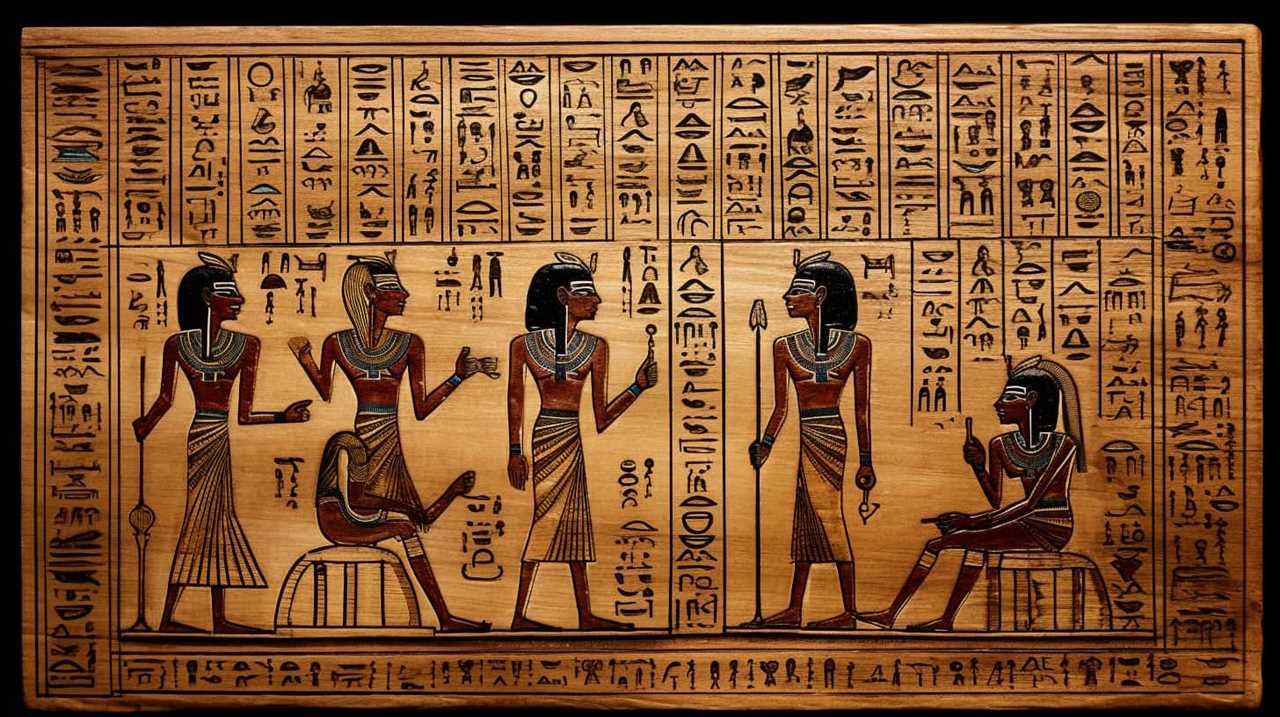
While delving into the secrets of ancient Egypt, we have unearthed valuable insights hidden within the intricate hieroglyphics. These enigmatic symbols, etched onto the walls of temples and tombs, play a crucial role in understanding the beliefs and culture of a civilization that thrived thousands of years ago.
Join us as we delve into the enchanting world of Egyptian hieroglyphic sayings, deciphering their meanings and unraveling their mysteries. From the timeless wisdom of Ma’at to the eternal flame of Ra, we will explore the profound insights that shaped the lives of the pharaohs and their subjects.
Prepare to embark on a voyage of mastery, as we bring to light the nine best Egyptian hieroglyphic sayings ever deciphered.
Key Takeaways
- Egyptian hieroglyphic sayings provide profound insights into ancient Egyptian beliefs and values.
- Decoding hieroglyphic messages reveals ancient wisdom and offers a deeper understanding of ancient Egyptian society.
- Hieroglyphic sayings emphasize the importance of maintaining a harmonious relationship with the Divine Pharaoh for prosperity and protection.
- Understanding hieroglyphs is crucial for unraveling the mysteries of ancient Egyptian civilization and gaining insights into their culture and history.
The Power of Ma’at
One of the most powerful and enduring concepts in ancient Egyptian civilization is the belief in the power of Ma’at. Ma’at represents the fundamental principle of balance and harmony that governs the universe. The ancient Egyptians believed that maintaining the power of balance, or Ma’at, was essential for the well-being and prosperity of society.
The concept of Ma’at was deeply ingrained in every aspect of Egyptian life, from religious rituals to the administration of justice. It was believed that when Ma’at was upheld, order and stability prevailed. The pharaoh, as the earthly embodiment of Ma’at, was responsible for upholding this balance and ensuring that justice was served.
The power of Ma’at also encompassed the notion of ancient wisdom. The Egyptians believed that the principles of Ma’at were derived from the wisdom of their gods and ancestors. This ancient wisdom guided their understanding of the natural world and their place within it.
The belief in the power of Ma’at continues to resonate throughout history, inspiring countless generations to strive for balance and harmony in their lives. It serves as a reminder of the importance of maintaining equilibrium in a world that’s constantly changing. The power of Ma’at remains an enduring legacy of ancient Egyptian civilization.
Life’s Journey in the Nile
How can we navigate Life’s Journey in the Nile?
The Nile River, with its powerful currents and treacherous waters, serves as a metaphor for the challenges we face in life. Just as the ancient Egyptians relied on the Nile for sustenance and prosperity, we too must navigate the obstacles that come our way and find our inner strength to overcome them.
To evoke emotion in our audience, let’s consider two sub-lists:
Navigating Obstacles:
- The Nile, with its unpredictable floods and dangerous wildlife, symbolizes the hurdles we encounter in life. We must learn to adapt and find alternative paths when faced with unexpected challenges.
- Like the ancient Egyptians who built canals and irrigation systems to control the Nile’s flow, we must develop strategies and tools to overcome obstacles and steer our lives in the desired direction.
Finding Inner Strength:
- The Nile’s journey from the heart of Africa to the Mediterranean Sea is an arduous one. Similarly, our life’s journey requires resilience and perseverance. We must tap into our inner strength to keep moving forward, even in the face of adversity.
- Just as the Nile’s waters provide sustenance to the fertile lands it touches, we must nourish our minds and souls to find the strength to overcome challenges. Cultivating self-care practices and seeking support from loved ones can help us navigate life’s journey with grace and resilience.
Wisdom of the Sphinx
As we explore the subtopic of ‘Wisdom of the Sphinx’, we encounter a trove of hidden riddles and ancient symbols that have fascinated scholars and historians for centuries.
The Sphinx, with its enigmatic gaze and mysterious presence, holds a wealth of wisdom that transcends time.
Sphinx’s Hidden Riddles
After deciphering the best Egyptian hieroglyphic sayings, we discovered the profound wisdom of the Sphinx’s hidden riddles.
The Sphinx, with its enigmatic expression and majestic presence, has captivated the human imagination for centuries. Its riddles, carefully crafted and tucked away in the sands of time, hold the key to unlocking ancient secrets.
These riddles aren’t mere puzzles to be solved, but rather profound teachings that offer insight into the human condition and the mysteries of existence. They challenge our intellect and provoke introspection, pushing us to delve deeper into the realms of knowledge and wisdom.
The Sphinx’s riddles, when deciphered, reveal truths that are timeless and universal, reminding us of the power of ancient wisdom in guiding our modern lives.
Now, let’s explore the ancient symbols and their modern meaning.
Ancient Symbols, Modern Meaning
We have uncovered the modern meaning behind the ancient symbols of the Sphinx, revealing a wealth of wisdom.
Egyptian hieroglyphic symbols have intrigued scholars and enthusiasts for centuries, serving as a window into the ancient Egyptian civilization. Decoding these symbols allows us to gain insight into the beliefs, values, and knowledge of the ancient Egyptians. The hieroglyphs often depict aspects of daily life, religious rituals, and divine beings.
Through careful analysis and comparison, we’ve been able to decipher the hidden messages encoded in these symbols, unveiling their true significance. These ancient symbols, once enigmatic, now offer profound insights into the mindset and worldview of the Egyptian people.
Decoding Wisdom Through History
Continuing our exploration of ancient Egyptian hieroglyphic symbols, let’s delve into the profound wisdom revealed by the enigmatic Sphinx. Decoding ancient wisdom through the historical symbolism of this majestic creature allows us to tap into the collective knowledge of our ancestors.
Here are two sub-lists that evoke emotion in our audience: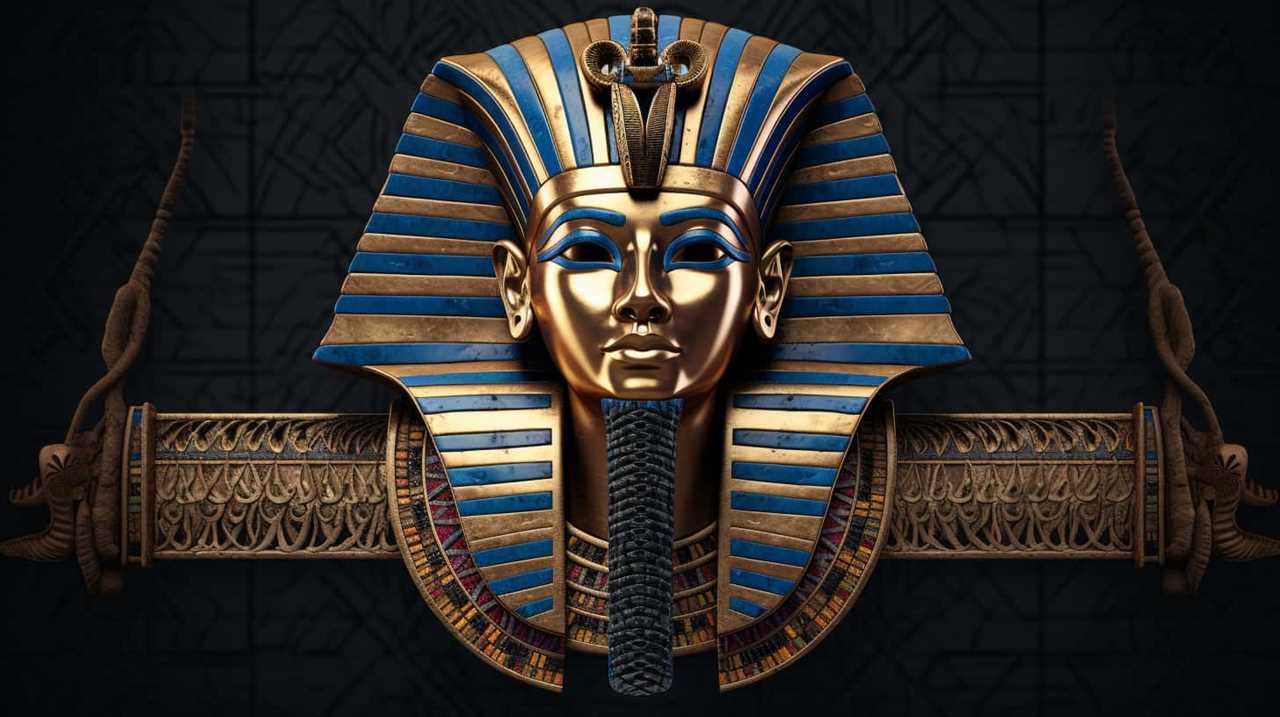
- Eternal Guardians of Mysteries:
- The Sphinx stands as a testament to the timeless pursuit of knowledge.
- Its inscrutable gaze beckons us to uncover the secrets of the past.
- Unveiling the Truth Within:
- Through deciphering hieroglyphic messages, we gain access to the ancient wisdom embedded in the Sphinx’s engravings.
- The historical symbolism of this iconic figure reveals profound insights about life, death, and the human condition.
The Magic of the Ankh
Rarely do we encounter an ancient Egyptian symbol as powerful and enigmatic as the Ankh. The Ankh, also known as the Key of Life, is a symbol that holds deep significance in Egyptian culture. It is believed to represent eternal life and immortality, making it one of the most revered symbols in ancient Egypt.
The symbolism of the Ankh is multi-faceted and rich in meaning. Its looped top represents the eternal cycle of life, while the vertical line represents the path of the soul. Together, they symbolize the union of opposites, the balance between life and death, and the eternal nature of the soul.
In Egyptian mythology, the Ankh was often associated with gods and goddesses, who were believed to hold the power of life and death. It was also believed to be a talisman that could bring protection, good fortune, and fertility to its wearer.
To better understand the symbolism of the Ankh, let us explore its various meanings and interpretations in the table below:

| Symbolism | Meaning |
|---|---|
| Eternal Life | Represents the concept of life beyond death |
| Balance | Symbolizes the harmony between opposites |
| Fertility | Associated with the power of creation and reproduction |
As we delve deeper into the mysteries of ancient Egypt, the Ankh continues to captivate us with its magic and profound symbolism. It serves as a reminder of the enduring legacy and wisdom of this ancient civilization.
Embracing the Eye of Horus
When exploring the captivating world of Egyptian hieroglyphic sayings, one can’t overlook the significance of embracing the Eye of Horus. This ancient symbol holds deep symbolic meaning, representing protection, healing, and intuition.
Horus, the falcon-headed god, is revered as a powerful and watchful deity, making the Eye of Horus a potent talisman to embrace and invoke.
Understanding the cultural significance of this symbol allows us to delve into the rich tapestry of Egyptian beliefs and traditions.
Symbolic Meaning of Eye
We are fascinated by the Symbolic Meaning of the Eye, as it encompasses the embrace of the Eye of Horus. The ancient Egyptians attributed great symbolic significance to the eye, believing it to be a powerful symbol of protection, healing, and knowledge. The mythological origins of this symbolism can be traced back to the Eye of Horus, a symbol of the god’s all-seeing power and divine protection.
The Eye of Horus represents clarity and vision, serving as a reminder to seek wisdom and enlightenment. It symbolizes the concept of ‘utchat,’ or the eye of Ra, which was believed to bring protection against evil forces and ward off negative energy.
Understanding the symbolic meaning of the eye allows us to delve deeper into the rich cultural and spiritual traditions of ancient Egypt, unlocking valuable insights into their worldview and beliefs.
Horus as Protective Deity
As believers in the power of ancient Egyptian hieroglyphic sayings, we embrace the protective deity Horus and his association with the Eye of Horus. Horus, often depicted as a falcon-headed god, was one of the most significant deities in the ancient Egyptian pantheon. He was considered the protector and ruler of Egypt, embodying the divine kingship.
Horus’ association with the Eye of Horus adds to his protective role. The Eye of Horus symbolizes royal power, health, and prosperity. Amulets in the shape of the Eye of Horus were worn by both the living and the deceased as a means of protection. These amulets were believed to ward off evil and ensure the wearer’s well-being.
The symbolism of the falcon and the significance of amulets connected to the Eye of Horus demonstrate the enduring belief in Horus as a powerful guardian and protector.
Cultural Significance of Eye
Continuing our exploration of the cultural significance of the Eye of Horus, we delve into its embrace as believers in the power of ancient Egyptian hieroglyphic sayings. The Eye of Horus holds deep cultural symbolism and carries a profound historical interpretation.
The Eye of Horus embodies protection and healing, offering a sense of security and warding off evil forces. It symbolizes the watchful and compassionate eye of a god, providing guidance and wisdom to those who seek it.
The Eye of Horus also represents the concept of resurrection and eternal life. It signifies the cyclical nature of existence, reminding us that life and death are intertwined, and that death is merely a transition to a different state of being.
Understanding the cultural symbolism and historical interpretation of the Eye of Horus allows us to appreciate its significance as a powerful symbol in ancient Egypt. It serves as a reminder of the profound beliefs and values held by the ancient Egyptians, and continues to inspire and captivate us today.
The Balance of Isfet and Ma’at
Exploring the delicate equilibrium between Isfet and Ma’at, we delve into the ancient Egyptian belief system. The importance of balance was a central concept in their worldview, as they sought to maintain harmony in all aspects of life. Isfet, representing chaos, disorder, and injustice, was seen as the antithesis of Ma’at, which symbolized order, balance, and justice.
To understand Isfet and Ma’at, one must grasp the fundamental principles that guided ancient Egyptians. Isfet was associated with actions and behaviors that disrupted the natural order of the universe. It represented negative qualities such as violence, dishonesty, and greed. Ma’at, on the other hand, encompassed positive attributes like truth, harmony, and righteousness. It was believed that upholding Ma’at ensured the smooth functioning of the world and the well-being of individuals.
Maintaining the balance between Isfet and Ma’at was vital for the Egyptians. They believed that if Isfet gained dominance, chaos would prevail, leading to disasters and calamities. Therefore, individuals were expected to live their lives in accordance with Ma’at, striving to uphold its principles in their thoughts, words, and actions.
Rebirth Through the Scarab Beetle
The Scarab Beetle symbolizes rebirth in ancient Egyptian hieroglyphic sayings. The ancient Egyptians believed that the scarab beetle, also known as the dung beetle, represented the cycle of life and death. This symbolism can be seen in various aspects of their culture and religious beliefs.
The scarab beetle’s behavior of rolling dung into a ball and burying it in the ground was seen as a representation of the sun’s daily journey across the sky. Just as the sun would disappear at night and rise again in the morning, the scarab beetle would emerge from the ground, symbolizing rebirth and renewal.
The scarab beetle also played a significant role in the afterlife beliefs of the ancient Egyptians. They believed that the beetle was associated with the god Khepri, who was responsible for the creation and renewal of life. The scarab amulets, often placed on the mummified bodies of the deceased, were believed to provide protection and ensure a successful journey into the afterlife.

In addition to its symbolism of rebirth, the scarab beetle also represented fertility and regeneration. The Egyptians believed that the beetle possessed the power to bring about new life and restore what was lost. This belief in the scarab beetle’s ability to bring about renewal and transformation is a testament to the profound impact it had on ancient Egyptian beliefs.
Respecting the Divine Pharaoh
As we delve further into ancient Egyptian hieroglyphic sayings, it is evident that our reverence for the Divine Pharaoh is paramount. The Egyptians believed that the Pharaoh was not just a mortal ruler, but a divine being with a direct connection to the gods. This belief was deeply ingrained in their society and shaped their rituals and customs.
To demonstrate the importance of respecting the Divine Pharaoh, let us examine some hieroglyphic sayings that highlight this reverence:
| Hieroglyphic Saying | English Translation |
|---|---|
| 👑👁️👑 | The Pharaoh is the all-seeing eye of the gods. |
| ⚡🌞⚡ | The Pharaoh is the powerful sun, radiating divine energy. |
| 🌺👑🌺 | The Pharaoh is the beautiful flower, blooming with divine grace. |
| 🌍👑🌍 | The Pharaoh is the earth itself, guiding and protecting his people. |
| ⚖️👑⚖️ | The Pharaoh is the just balance, ensuring harmony and order in the kingdom. |
These sayings reveal the Egyptians’ deep respect for their divine ruler. They saw the Pharaoh as the embodiment of the gods on Earth, responsible for maintaining the balance between the mortal and divine realms. Through ancient rituals and ceremonies, they sought to honor and appease the Pharaoh, believing that his favor would bring prosperity and protection to the kingdom.
Understanding the significance of these hieroglyphic sayings allows us to gain insight into the ancient Egyptians’ mindset and worldview. It highlights the central role played by the Divine Pharaoh in their society and underscores the importance they placed on maintaining a harmonious relationship with their ruler.
The Eternal Flame of Ra
Continuing our exploration of ancient Egyptian hieroglyphic sayings, let’s delve into the captivating realm of ‘The Eternal Flame of Ra’. In ancient religious practices, the solar deity Ra held a significant place of reverence and worship. The Eternal Flame of Ra symbolized the eternal power and presence of this mighty deity.
Here are two sub-lists that will surely evoke emotions in our audience:
- The Divine Light:
- The Eternal Flame of Ra represents the divine light that illuminates the world, bringing warmth, life, and energy to all living beings.
- This sacred flame is believed to be the embodiment of Ra’s eternal power, radiating brilliance and providing spiritual guidance to the ancient Egyptians.
- The Cycle of Life:
- The Eternal Flame of Ra also symbolizes the cyclical nature of life, mirroring the rising and setting of the sun each day.
- Just as the sun rises and sets, the flame of Ra represents the eternal cycle of creation, death, and rebirth, reminding us of the impermanence of all things.
Understanding the significance of the Eternal Flame of Ra allows us to gain deeper insight into the ancient religious practices of the Egyptians. It reminds us of their profound connection to the sun and their belief in the eternal power and presence of the solar deity.
Frequently Asked Questions
How Were Hieroglyphics Deciphered and What Methods Were Used?
To decipher hieroglyphics, we utilized various methods such as the Rosetta Stone and the work of key figures like Jean-François Champollion. By comparing known languages, we identified phonetic and symbolic elements, unlocking the secrets of ancient Egypt’s written language.
Are There Any Hieroglyphic Sayings That Are Still Considered Undeciphered or Mysterious?
Undeciphered hieroglyphic sayings and mysterious hieroglyphic phrases continue to captivate scholars. Despite our best efforts, these enigmatic messages remain elusive, shrouded in the ancient secrets of the Egyptian civilization.
Can You Provide Examples of Hieroglyphic Sayings That Have Been Widely Used in Ancient Egyptian Culture?
Examples of widely used hieroglyphic sayings in ancient Egyptian culture include phrases like "life, prosperity, and health" and "eternal life." These sayings were deciphered using methods such as the Rosetta Stone and the work of Champollion.
What Role Did Hieroglyphic Sayings Play in Ancient Egyptian Religious Practices?
Hieroglyphic sayings played a pivotal role in ancient Egyptian religious practices. They were not only a form of artistic expression, but also held deep significance in the literature of the time.
Are There Any Hieroglyphic Sayings That Have Been Found to Have Multiple Interpretations or Meanings?
Multiple interpretations and meanings are common in hieroglyphic sayings. The complexity and symbolism of the ancient Egyptian language allow for various understandings, adding depth to the study of hieroglyphics.
Are the Deciphered Egyptian Hieroglyphic Sayings Similar to the Translated Mesopotamian Clay Tablet Inscriptions?
The deciphered Egyptian hieroglyphic sayings are not exactly similar to translating Mesopotamian clay tablet inscriptions. While both involve unraveling ancient texts, the languages, writing systems, and cultural contexts are distinct. The Egyptian hieroglyphs are pictorial, while Mesopotamian cuneiform uses wedge-shaped characters. Each presents unique challenges to translators.
Can the Deciphering of Nietzsche Morality Quotes Provide Insight into Deciphering Egyptian Hieroglyphic Sayings?
The study of Nietzsche morality quotes decoded can provide valuable insight into deciphering Egyptian hieroglyphic sayings. Both involve the interpretation of philosophical and cultural symbols, and understanding one can enhance the understanding of the other. The process of decoding one can inform and enrich the process of decoding the other.
Conclusion
In the majestic tapestry of ancient Egypt, the hieroglyphic sayings serve as hidden gems of wisdom, guiding us through the complexities of life. Like the sacred Nile, they flow with the power of Ma’at, illuminating the path of our life’s journey.
They reveal the profound knowledge held by the Sphinx, the magic woven into the Ankh, and the eternal flame of Ra. Through the scarab beetle, we learn the beauty of rebirth, while the divine pharaoh teaches us the importance of respect.
These hieroglyphic sayings are a treasure trove of enlightenment, waiting to be unraveled by those who seek the secrets of Egypt’s ancient past.
Lauren’s talent in writing is matched by her passion for storytelling. Her love for books and deep understanding of culture and entertainment add a distinct flavor to her work. As our media and press contact, Lauren skillfully bridges the gap between afterQuotes and the broader media landscape, bringing our message to a wider audience.
-

 Funerals Quotations3 months ago
Funerals Quotations3 months agoSoothing Hope Quotes for Funeral Reflections
-

 TV Shows Quotations2 months ago
TV Shows Quotations2 months agoTop 4 Unforgettable TV Drama Monologues
-

 Movies Quotations4 weeks ago
Movies Quotations4 weeks agoUnforgettable Cult Movie Quotes: A Compiled List
-

 Education and Knowledge1 week ago
Education and Knowledge1 week agoUnlock Success with the Best Study Motivation Quotes
-

 Travel and Exploration Quotations3 weeks ago
Travel and Exploration Quotations3 weeks agoWisdom on Waves: Notable Maritime Explorer Quotations
-

 Education and Knowledge1 week ago
Education and Knowledge1 week agoBest Study Quotes: Unlock Student Potential!
-

 Military Quotations2 months ago
Military Quotations2 months agoInspiring Military Quotations for Strength & Honor
-

 Travel and Exploration Quotations3 weeks ago
Travel and Exploration Quotations3 weeks agoWhy Travel Teaches Unforgettable Life Wisdom?


















